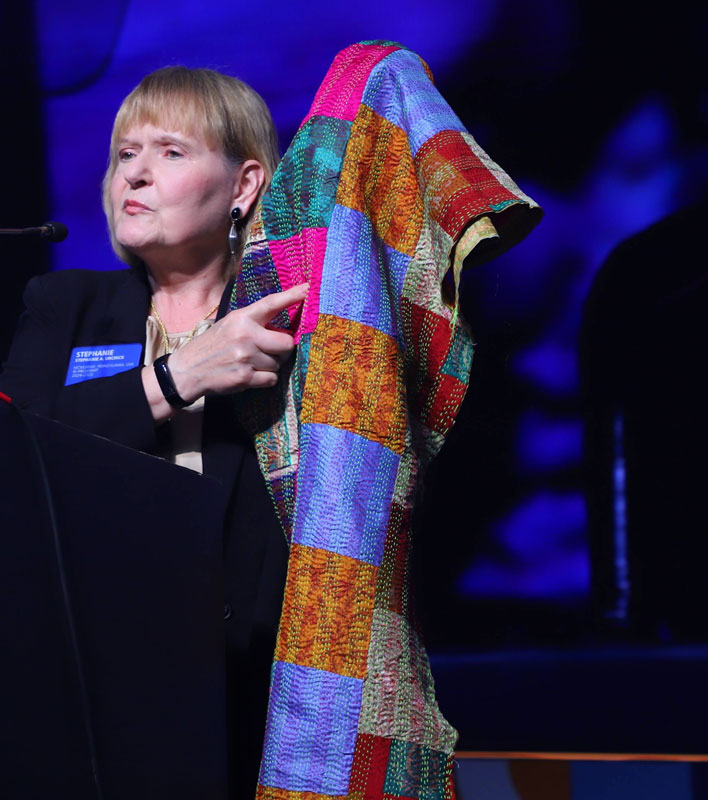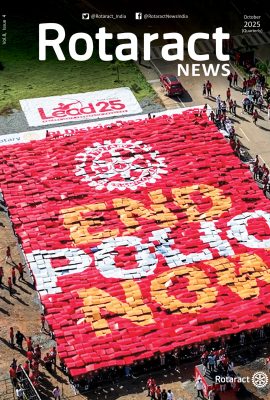
While Indian Rotarians were doing a great job in attracting new members to Rotary, attrition continued to be a problem and the challenge was to address issues related to attrition in different forms, RI President Stephanie Urchick said in her inaugural address at the Kochi Zone Institute.
The future of Rotary lay in growing it; and there were three ways to do that. “One, by attracting members to our traditional clubs. But for those not interested in our traditional clubs, let’s form new clubs with new models, providing new ways for people to come into our organisation. The third way is by retaining members we already have and that is the one we need to work on here in India,” she said.
Indian clubs had “no problem attracting new members; Your attraction rate is astounding.” But she had found after an analysis of membership reports from India that there is always “a graph that goes up and then dips on Dec 31 and July 1, showing members have left and not paid their dues. The good news is that after that dip, we rebound. But my point is what would that graph be like if we had not lost those members? We can prevent that dip if we can make our clubs irresistible, so that people will want to stay.”
Just because you don’t have a title it doesn’t mean you are not a leader; so do continue the good projects.
— Stephanie Urchick, RI President
The answer to this, said the RI President, lay in the Action Plan which specifically talks about how every club can use the four priorities listed there; “to take a look at the culture of the club, what the club is doing and determine how can we go from good to great, or better if it wasn’t so good to begin with. So do pay attention to the Action Plan and then you can address the problem. Instead of falling off every December and July, we should continue to grow.”
Stephanie said this was important to her “because when I wake up every morning I realise I don’t have 30 years in front of me to do Rotary. The Rotaractors do, but I don’t. I’m happy to see Rotaractors and young professionals coming to Rotary because I know the magic of our organisation will continue when I am no longer here. And that’s true for every single one of us here.”
She was most grateful for the 34 years spent in Rotary, which had given her such a rich experience in core values such as leadership, integrity, diversity and so on.

Moving on to the other important aspect, she talked about the ‘built in attrition’ factor “which means that if we are not intentional about increasing our members consistently, our club will certainly go away eventually.” This would happen each year; if the club had 20 members, two would pass on, two would move out due to a transfer and one might just leave because he didn’t enjoy what the club was doing. “So the first year, if you don’t add new members, your club of 20 will suddenly become 15. Next year, it would have only 12 members if you are not intentional… every club in the world will have to be intentional about replacing members and sharing the magic of Rotary so that we continue to move into a bright and healthy future.”
The second big idea Rotarians need to focus on was that “we are peacebuilders and we have many tools to help us with that. Rotary is built on a foundation of world understanding and peace. But we are not peace brokers or people and organisation that can negotiate the release of hostages or can stop a war. That’s not what we do. As peacebuilders, we prevent conflict before it happens. We create the conditions that need to exist for a peaceful society. If people don’t have enough to eat, we go in and feed them. If people need clean water, we go in and provide it. If people are uneducated, we go in and provide education. If people need employment, we give them skills. So we create the conditions necessary for a peaceful society to exist. Desperate people do desperate things; those without water will eventually fight over access to clean water.”
We are not peace brokers or people who can negotiate the release of hostages or stop a war. As peacebuilders, we prevent conflict before it happens.
— Stephanie Urchick, RI President
Stephanie urged Rotarians to visit the Positive Peace Academy at the Rotary Learning Centre. It was an online programme where in two hours, “you can learn about the eight pillars of positive peace.” Another useful programme was the Youth Exchange Programme, where students visit different countries, interact with host families, teachers, Rotarians, and learn new cultures, languages and perspectives. In essence, they were building peace, one at a time.
A terrific programme she urged Rotarians to implement was the Rotary Peace Pole Project, which involved planting poles in different places and communities. “These will become visible monuments carrying the inscription ‘May Peace Prevail on Earth’ in local languages. The new Peace Poles also have a QR code containing information about Rotary. “I love the Peace Pole Project because not only does it instil a sense of pride in the local Rotarians, it’s a visual monument that reminds the community that Rotary is about peacebuilding,” she added.

The idea was not to stop wars, but to engage the local people in a conversation about the need for world peace.
The RI President added that to celebrate the milestone of establishing Rotary’s newest Peace Centre in Istanbul, she is holding a Presidential Peace Conference titled Healing in a Divided World on Feb 20–21, 2025. “In that symposium with fabulous speakers, we will talk about peace and engage in peace activities, plant a Peace Pole, visit the Peace Centre and meet the students undergoing the programme.” She urged Rotarians in the hall to attend that conference in Istanbul.
She herself had visited a graduation ceremony at a Peace Centre in the US, and heard the presentations of students on what they would do with the learning experience gained here. “As I listened with amazement as 25 young people stood up and talked about the impressive ways in which they were going to change the world, I thought, what was I doing when I was 25 years old? Well, I certainly wasn’t changing the world!”
Saying that this was her 10th Institute, Stephanie also reiterated the continuity mantra that is so important for Rotary leadership and projects. “Just because our leadership changes it doesn’t mean we should stop doing projects,” and recalled that Shekhar Mehta as RI President had given name to a programme (Empowering girls) that had “caught fire everywhere, and clubs were continuing to support young girls and women. Last year Gordon (McInally) woke us up to the idea how important it is to deal with mental health issues and help remove the associated stigma and clubs around the world have embraced it and initiatives on mental health are happening.”

So even while embracing change in leadership — at all levels — good programmes should continue, remembering that “when new people come in, we get fresh ideas and new perspectives. So let’s focus and work with the people who come in, keeping in mind that just because you don’t have a title it doesn’t mean you are not a leader. We have to work together to make our clubs strong, so that we can create lasting change.”
Giving the example of a quilt, where each square is beautiful individually and even more colourful and vibrant when put together, she said Rotary was just like such beautiful tapestry or quilt with different squares… “they don’t speak the same language, one is male, the other female or transgender, and so on. Together they represent how unique we are as an organisation. It is our differences that make us the strongest and the best in the world.”
In his address, convenor and RI Director Anirudha Roychowdhury said that led by chair and PDG John Daniel, the Institute team had worked really hard to make it a memorable experience with thrilling events such as a snake boat race, a golf tournament to raise funds to TRF, a half marathon and unique projects which would be inaugurated at the venue. There were 46 Rotaractors participating in the Institute, including DRRs and DRRs-elect.
Welcoming the delegates John Daniel said that a record number of 1,200 participants had registered at the Institute.
Pictures by Hemant Banswal





